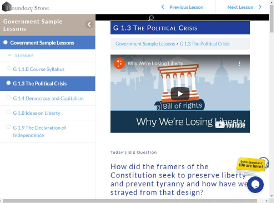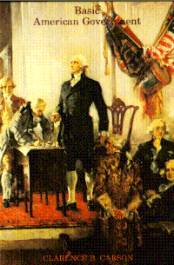In Basic American Government, Clarence Carson brings life to the study of government by putting it in context, dealing with the people and ideas that formed our government rather than treating us to lifeless facts. Carson tackles topics others shy away from. I was particularly pleased to see that he accurately deals with the definition of our form of government as a republic rather than a democracy. He credits the Judeo-Christian view of man as the reason that our founding fathers chose that form of government. Recognizing the tendency in people toward selfishness, greed, and other sins, the republican form of government includes checks and balances that can limit temptations for abuse by those in power.
Carson frequently addresses the expansion of federal power at the expense of states' rights. One such instance is in relation to the Seventeenth Amendment, which provided for the direct election of senators. He shows how this was a dramatic shift from the selection of senators by state legislatures, which moved our country away from the intended form of republicanism and toward democracy.
The entire book is 592 pages in length, but the actual text is only 480 pages. A glossary, notes, documents, and an index comprise the rest. Still, this is a hefty book for some high schoolers and can be slow going at times, but for the most part it's very interesting reading.
It is arranged in four sections: Introduction and Examination of American Government, Background of Political Thought and Practice, American Government in the 19th Century, and Leviathon: American Government in the 20th Century. That last section title should give you a clear idea of Carson's views of government!
The arrangement makes it possible to use the book in sections. You might do the introduction, then use the second section in conjunction with world history studies. The last two sections could be studied in conjunction with U.S. history. Thus, reading the book could be spread out over a couple of years. However, the usual approach is to complete the study of government in one semester.
Boundary Stone, the publisher of this textbook, has produced a study guide for students and a teacher guide, both written by Cathe Cleveland. Previously, there were no study questions, teacher guide, or answer keys for the textbook. So these two new resources make this textbook much more usable than it is on its own. Both the student study guide and the teacher guide are available as PDFs. Students using the course as laid out in the guides will also read The Law by Frederic Bastiat. You can download a copy of The Law for free, or you can buy a printed copy.
The study guide is a consumable workbook with space for students to write their answers to chapter assignments. Near the front is a one-page chart showing a semester lesson plan with detailed assignments. For each chapter, the student guide has an "identification" section with names or terms for which students will write brief entries. Then they have a number of review questions for which they will write short-essay answers. The review questions show the page number(s) in the textbook where each topic is covered, saving students time searching for information. At the end of the student guide are the instructions for a research paper project (assigned in the lessons), a "Supreme Court Decision Worksheet" (to be used with an activity), and discussion questions that will be used at the beginning of the course.
The teacher guide has all of the content of the student guide plus much more. It also takes the information from the one-page lesson plan chart in the study guide and presents it with more detail on seven pages. You might want to print these pages for students who want the detailed information.
In the teacher guide, the identification sections and review questions for each chapter have suggested responses. Toward the end of the guide, there are diagnostic quizzes for each unit (like pre-tests), topic quizzes, and unit tests. Answer keys are included for all of these. At the end are the same research paper project instructions, "Supreme Court Decision Worksheet," and discussion questions that are in the student study guide.
Online Course
 Boundary Stone has also created a fabulous online version of this course that aligns with the student and teacher guides and is self-paced. The publisher says that the course will usually be completed in one semester. However, you receive access for ten months, and students might want to take longer to complete this course since it has even more content than the textbook course that uses the same teacher and student guides.
Boundary Stone has also created a fabulous online version of this course that aligns with the student and teacher guides and is self-paced. The publisher says that the course will usually be completed in one semester. However, you receive access for ten months, and students might want to take longer to complete this course since it has even more content than the textbook course that uses the same teacher and student guides.
These online lessons include step-by-step lesson assignments, YouTube videos, flashcards, questions with various formats for online responses, and printable student study-guide pages. Tests and quizzes can be taken online, but teachers can use printed tests if they prefer.
PDF copies of both the student study guide and the teacher guide are included with the purchase of the online course, but students still need the printed textbook. Parents or teachers will need to manually check student work completed on the study-guide pages.
The YouTube videos selected for the lessons come from a wide range of online platforms such as Prager University; Acton Institute; The Heritage Foundation; and The Institute for Faith, Work, and Economics. These videos are outstanding, and I believe that many students will appreciate both the videos and other online activities even if they require more time.
Summary
Basic American Government is one of the books I would put on my must-read list. Its combination of theory and practical application draws students into the age-old conversation about the proper structure of government and the challenge of balancing the government's power with freedom for its citizens. The new course materials now make it much more usable for students and more practical for parents and teachers to administer.









